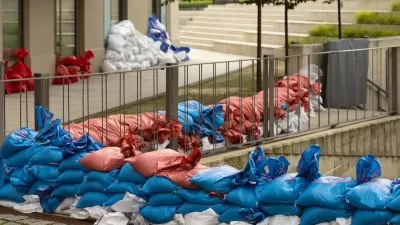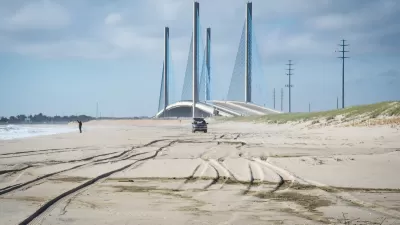Artificial reefs could offer a ‘softer’ flood management and erosion solution that doesn’t disrupt the flow of sediment.

Two pilot projects in Illinois are testing the potential of artificial reefs to reduce flooding risks in the Great Lakes, reports Lily Carey for Inside Climate News. The concept seeks to offer an alternative to concrete breakwaters and other flood mitigation tools that can exacerbate flood risk by compounding the effects of erosion.
Scientists managing the pilot projects plan to study how the reefs impact local shorelines and whether they could be a scalable solution for large lakes. According to researcher Hillary Glandon, “This project was hoping to come up with some softer designs, not necessarily fully stopping that movement of sand and water, but also a more cost effective design.”
As Carey explains, “Lake Michigan is already home to a handful of artificial reefs, most of which are located farther from shore as a habitat for marine life. Some researchers in the U.S., though, say these could serve the dual purpose of boosting fish populations and preventing erosion, disrupting waves so that they’re less intense when they crash ashore.”
Because the shores of Lake Michigan are lined with hundreds of private lots, shoreline management has often been a complicated project. “That makes artificial reefs particularly alluring in the Great Lakes—they’re a way to block wave energy without making erosion worse for neighbors, and they’re far cheaper than traditional infrastructure.” However, a lack of familiarity with nature-based interventions and a historical reliance on seawalls and breakwaters keep many residents wary of artificial reefs.
FULL STORY: Artificial Reefs Can Mitigate Coastal Erosion in the Great Lakes. Will Cities Agree to Adopt Them?

Alabama: Trump Terminates Settlements for Black Communities Harmed By Raw Sewage
Trump deemed the landmark civil rights agreement “illegal DEI and environmental justice policy.”

Planetizen Federal Action Tracker
A weekly monitor of how Trump’s orders and actions are impacting planners and planning in America.

The 120 Year Old Tiny Home Villages That Sheltered San Francisco’s Earthquake Refugees
More than a century ago, San Francisco mobilized to house thousands of residents displaced by the 1906 earthquake. Could their strategy offer a model for the present?

In Both Crashes and Crime, Public Transportation is Far Safer than Driving
Contrary to popular assumptions, public transportation has far lower crash and crime rates than automobile travel. For safer communities, improve and encourage transit travel.

Report: Zoning Reforms Should Complement Nashville’s Ambitious Transit Plan
Without reform, restrictive zoning codes will limit the impact of the city’s planned transit expansion and could exclude some of the residents who depend on transit the most.

Judge Orders Release of Frozen IRA, IIJA Funding
The decision is a victory for environmental groups who charged that freezing funds for critical infrastructure and disaster response programs caused “real and irreparable harm” to communities.
Urban Design for Planners 1: Software Tools
This six-course series explores essential urban design concepts using open source software and equips planners with the tools they need to participate fully in the urban design process.
Planning for Universal Design
Learn the tools for implementing Universal Design in planning regulations.
Clanton & Associates, Inc.
Jessamine County Fiscal Court
Institute for Housing and Urban Development Studies (IHS)
City of Grandview
Harvard GSD Executive Education
Toledo-Lucas County Plan Commissions
Salt Lake City
NYU Wagner Graduate School of Public Service





























